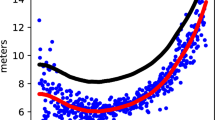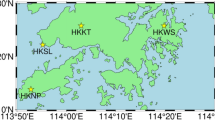Abstract
The ionosphere affects the propagation of global positioning system signals. Due to their special features, the equatorial and low-latitude ionosphere may produce particularly severe effects on them. The ground-based augmentation system has been developed to meet the safety requirements of civil aviation. To evaluate the performance of such a system, a statistical simulation model of the global positioning system signal-in-space has been developed, considering several components. The present work will focus on: (1) the ionospheric delay, with basis on statistical distributions of vertical total electron content obtained by the combination of the International Reference Ionosphere with data from the Rede Brasileira de Monitoramento Contínuo, operated by Instituto Brasileiro de Geografia e Estatística; (2) cycle ambiguity, characterized through the processing of the same data set; (3) ionospheric amplitude scintillation, simulated with basis on proper indices and the α–μ probability distribution; and (4) ionospheric phase scintillation, generated according to its standard deviation. The statistical simulation model is based on a set of representative geophysical parameters and may be used to generate time series of pseudorange, carrier phase, and received signal power, to be applied as inputs to existing or future ground-based augmentation system testbeds. This provides an alternative to experimental data collection, which could be expensive and time-consuming. Additionally, such data may not be available for all regions and critical geophysical conditions of interest.






Similar content being viewed by others
Data availability
The RBMC/IBGE data can be accessed at https://www.ibge.gov.br/geociencias/informacoes-sobre-posicionamento-geodesico/rede-geodesica/10841-rbmc-rede-brasileira-de-monitoramento-continuo-dos-sistemas-gnss.html?=&t=o-que-e. The INCT GNSS NavAer data can be accessed at http://ismrquerytool.fct.unesp.br/is/ using the ISMR Query Tools developed by Vani et al. (2017). Solar and geomagnetic indices can be accessed at https://omniweb.gsfc.nasa.gov/form/dx1.html.
References
Abdu MA (2016) Electrodynamics of ionospheric weather over low latitudes. Geosci Lett 3:11. https://doi.org/10.1186/s40562-016-0043-6
Abramowitz M, Stegun IA (1972) Handbook of mathematical functions. Dover, New York
Akala AO, Somoye EO, Adewale AO, Ojutalayo EW, Karia SP, Idolor RO, Okoh D, Doherty PH (2015) Comparison of GPS-TEC observations over Addis Ababa with IRI-2012 model predictions during 2010–2013. Adv Space Res 56(8):1686–1698. https://doi.org/10.1016/j.asr.2010.01.003
Basu Su, Basu S, McClure JP, Hanson WB, Whitney HE (1983) High resolution topside in situ data of electron densities and VHF/GHz scintillations in the equatorial region. J Geophys Res Space Phys 88(A1):403–415. https://doi.org/10.1029/ja088ia01p00403
Bilitza D, Altadill D, Zhang Y, Mertens C, Truhlik V, Richards P, Mckinnell L, Reinisch B (2014) The international reference Ionosphere 2012-a model of international collaboration. J Space Weather Space Clim 4(A07):1–12. https://doi.org/10.1051/swsc/2014004
Datta-Barua S, Lee J, Pullen S, Luo M, Ene A, Qiu D, Zhang G, Enge P (2010) Ionospheric Threat Parameterization for Local Area Global-Positioning-System-Based Aircraft Landing Systems. J Aircraft 47(4):1141–1151. https://doi.org/10.2514/1.46719
de Abreu AJ, Martin IM, de Jesus R, Bolzan M, Venkatesh K, Fagundes PR, Alves M, Gende M, Kumar S (2017) Comparison of GPS-TEC measurements with IRI2012-TEC predictions in the Brazilian sector during the unusual solar minimum 2009. Ann Geophys 60(3):1–10. https://doi.org/10.4401/ag-7300
de Paula ER et al (2007) Characteristics of the Ionospheric F-region plasma instabilities over Brazilian longitudinal sector. Indian J Radio Space Phys 36(4):268–277
de Paula ER et al (2021) Performance of 6 different global navigation satellite system receivers at low latitude under moderate and strong scintillation. Earth Space Sci 8(2):1–22. https://doi.org/10.1029/2020EA001314
Fougere PF (1985) On the accuracy of spectrum analysis of red noise processes using maximum entropy and periodogram methods: simulation studies and application to geophysical data. J Geophys Res Space Phys 90(A5):4355–4366. https://doi.org/10.1029/JA090iA05p04355
Gherm VE, Zernov NN (2015) Strong scintillation of GNSS signals in the inhomogeneous ionosphere: 2. Simul Transionospheric Channel Radio Sci 50(2):168–176. https://doi.org/10.1002/2014RS005604
Hofmann-Wellenhof B, Lichtenegger H, Wasle E (2008) GNSS–Global navigation satellite systems-GPS, GLONASS, Galileo and More. Springer, Wien
Humphreys TE, Psiaki ML, Hinks JC, O’Hanlon B, Kintner P (2009) Simulating ionosphere-induced scintillation for testing GPS receiver phase tracking loops. IEEE J Selec Top Signal Process 3(4):707–715. https://doi.org/10.1109/JSTSP.2009.2024130
Kim M, Choi Y, Jun HS, Lee J (2015) GBAS ionospheric threat model assessment for category I operation in the Korean region. GPS Solu 19(3):443–456. https://doi.org/10.1007/s10291-014-0404-6
Kintner PM, Ledvina BM, de Paula ER (2007) GPS and ionospheric scintillations. Space Weather. https://doi.org/10.1029/2006SW000260
Kelley MC (2009) The Earth’s ionosphere: plasma physics and electrodynamics, vol 43. Academic Press, San Diego
Lee J, Pullen S, Datta-Barua S, Enge P (2007) Assessment of Ionosphere Spatial Decorrelation for Global Positioning System-Based Aircraft Landing Systems. J Aircraft 44(5):1662–1669. https://doi.org/10.2514/1.28199
Mayer C, Belabbas B, Jakowski N, Meurer M, Dunkel W (2009) Ionosphere threat space model assessment for GBAS. In: Proceedings of the 22nd international technical meeting of the satellite division of the institute of navigation (ION GNSS 2009), Savannah, GA, pp 1091–1099
Moraes AO, Costa E, de Paula ER, Perrella WJ, Monico JFG (2014) Extended ionospheric amplitude scintillation model for GPS receivers. Radio Sci 49(5):315–329. https://doi.org/10.1002/2013RS005307
Moraes AO, Costa E, Abdu MA, Rodrigues FS, de Paula ER, Oliveira K, Perrella WJ (2017) The variability of low-latitude ionospheric amplitude and phase scintillation detected by a triple-frequency GPS receiver. Radio Sci 52(4):439–460. https://doi.org/10.1002/2016RS006165
Moraes AO, Vani BC, Costa E, Sousasantos J, Abdu MA, Rodrigues F, Gladek YC, de Oliveira CB, Monico JFG (2018) Ionospheric scintillation fading coefficients for the GPS L1, L2, and L5 frequencies. Radio Sci 53(9):1165–1174. https://doi.org/10.1029/2018RS006653
Oliveira CBA, Espejo TMS, Moraes AO, Costa E, Sousasantos J, Lourenço LFD, Abdu MA (2020) Analysis of plasma bubble signatures in total electron content maps of the low-latitude ionosphere: a simplified methodology. Surv Geophys 41(4):897–931. https://doi.org/10.1007/s10712-020-09584-7
Rino CL (2011) The theory of scintillation with applications in remote sensing. Wiley, Hoboken
Rino CL, Carrano CS, Groves KM, Roddy PA (2016) A characterization of intermediate-scale spread F structure from four years of high-resolution C/NOFS satellite data. Radio Sci 51(6):779–788. https://doi.org/10.1002/2015RS005841
Seeber G (2003) Satellite geodesy. Walter de Gruyter, Berlin
Vani BC, Shimabukuro MH, Monico JFG (2017) Visual exploration and analysis of ionospheric scintillation monitoring data: the ISMR query tool. Comput Geosci 104(7):125–134. https://doi.org/10.1016/j.cageo.2016.08.022
Acknowledgements
This work was performed in the framework of the INCT GNSS NavAer Project under grants Conselho Nacional de Desenvolvimento Científico e Tecnológico (CNPq) 465648/2014-2 and Fundação de Amparo à Pesquisa do Estado de São Paulo (FAPESP) 2017/50115-0. It was partly financed by Coordenação de Aperfeiçoamento de Pessoal de Nível Superior (CAPES), Brazil - Finance Code 001. T. M. Surco Espejo was supported by doctoral fellowships from CAPES 88887.165471/2018-00 and CNPq 165042/2018-4. E. Costa was supported by CNPq award PQ 305984/2019-5. A. O. Moraes was supported by CNPq award PQ 309389/2021-6. E. R. de Paula was supported by CNPq award PQ 302531/2019-0 and by FAPESP award 2018/23754-4. J. F. G. Monico was supported by CNPq award PQ 307417/2017-4. The authors thank Instituto Brasileiro de Geografia e Estatística (IBGE) for providing GPS data from Rede Brasileira de Monitoramento Contínuo (RBMC).
Author information
Authors and Affiliations
Corresponding author
Additional information
Publisher's Note
Springer Nature remains neutral with regard to jurisdictional claims in published maps and institutional affiliations.
Rights and permissions
About this article
Cite this article
Surco Espejo, T.M., Costa, E., Moraes, A.O. et al. A GPS signal-in-space simulation model for equatorial and low latitudes in the Brazilian longitude sector. GPS Solut 26, 94 (2022). https://doi.org/10.1007/s10291-022-01273-9
Received:
Accepted:
Published:
DOI: https://doi.org/10.1007/s10291-022-01273-9




